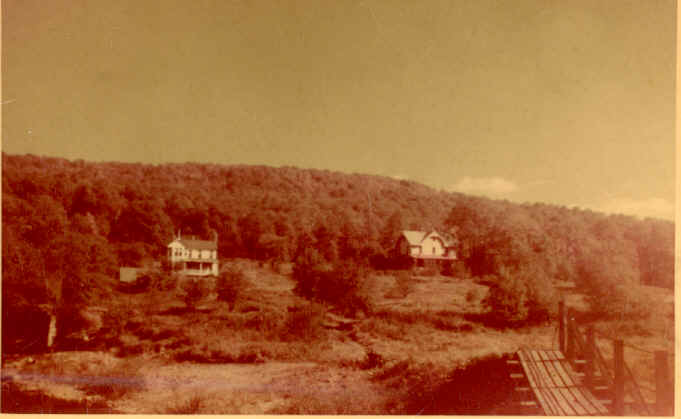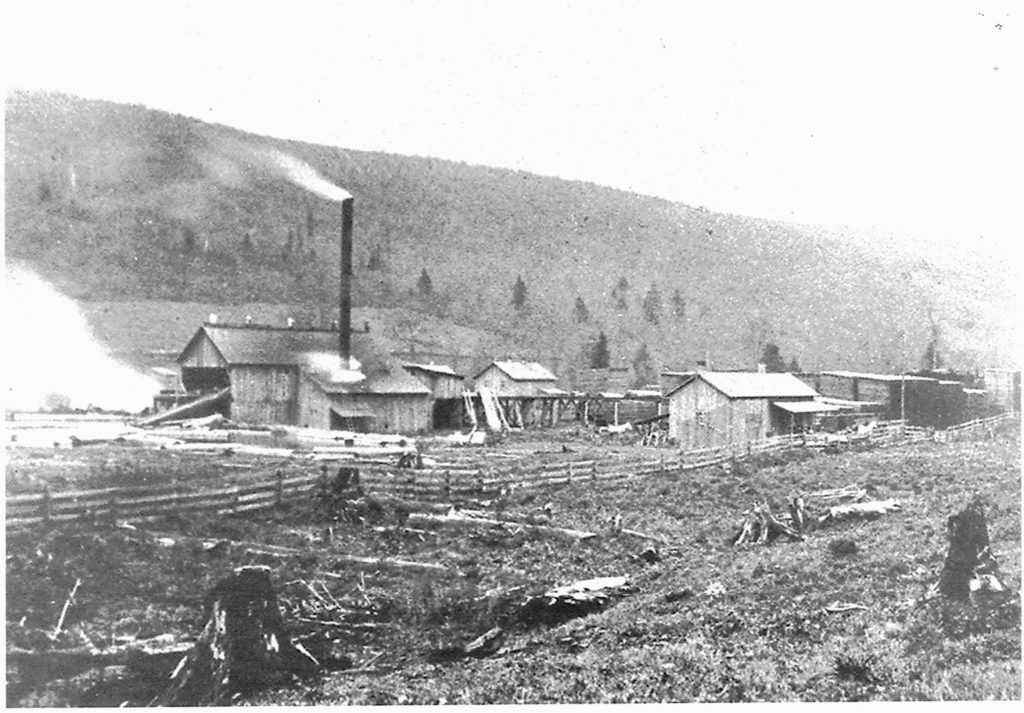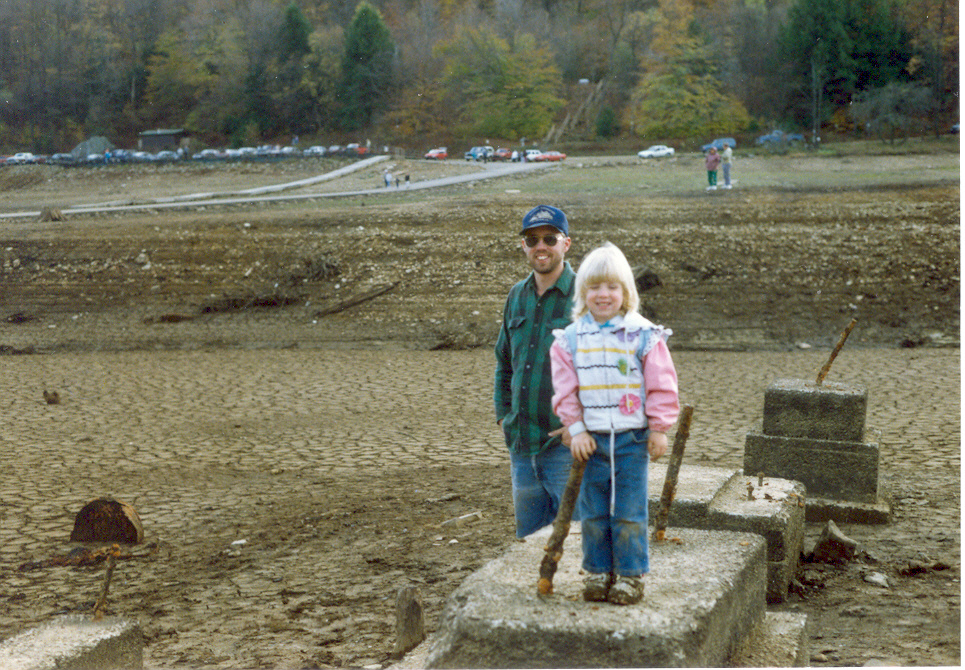The village of Instanter was a thriving community existing only to meet the needs of the Elk Tannery and it’s workforce. The Tannery in Instanter was constructed in 1889 and prospered quite well for many years, when rumors of it’s closing began to spread throughout the town. Then, on December 21, 1926, the rumors became fact as the newly acquired owners, the Elk Tanning Company, ceased operations permanently, leading to an eventual decline of the community. As such it’s residents began to migrate to other towns to find work, leading what remained to wither away or to be purchased as hunting outposts.
By 1948, the federal government began to acquire land and private buildings for the construction of the East Branch Flood Control Project. By this time not a whole lot was left of the once thriving community. Existing structures that remained were demolished or moved and the land cleared for the new lake that would take up behind the newly constructed earthen dam across the East Branch river near Glen Hazel. Soon the town of Instanter and it’s sister town of Straight were flooded and had remained only in memories and under water.


The following story is written by George & Margaret Rupprecht and appeared in the Spring 1979 issue of The Elk Horn.
Unless noted, pictures courtesy of Ray Allregretto
The year is 1889, the first tree was felled, the tannery, the saw mill, the stores and other businesses set up, right in the very heart of a deep, dense and dark forest, where, in the wilds of Jones Township, Elk County, were still found clean and sparkling streams.
The Johnsonburg and Clermont Railroad had just then been completed, its entire twenty mile length passing through this virgin forest land. The railroad was built by the Henry Bayard and Company of Philadelphia, large wholesale lumber dealers, owner of vast tracts of timber tracts in the area.

At the confluence of Instanter Run and Seven Mile Creek, Norman Schultz and J.B. Hoyt, Jr. decided this was the ideal location to establish a tannery as the terrain was well adapted to serve their purpose, there being an abundance of good clean water; and moreover, an unlimited supply of bark from the large tracts of hemlock timber was available from which the necessary acid used in the tanning process could be obtained.


The new village was named “New Instanter” as it was known there had been a town many years before called Instanter, near the head waters of Instanter Run at the site of the present town of Clermont, a distance of about seven miles. The old town of Instanter was established by Joel Bishop, land agent for Benjamin B. Cooper, a large land owner in that area. It was laid out very precisely and boasted of quite a number of log dwellings, a church, a school, the land sales office of the Holland Land Company and a municipal office where the residents of the district cast their votes on election days. However in 1812, at the beginning of the second war with England there was much apprehension among the general citizenry, who became fearful of a possible England victory and the normal results which would follow under such circumstances, Consequently, the town collapsed, the buildings were dismantled and all that remained was the memory of a town that seemed to have had a bright future.



The erection of the tannery was under the supervision of A. A. Clearwater, also serving as general superintendent of the large Wilcox tannery, also owned in part by the Schultz family. The leach house and the bark mill are in a building 35 feet by 250 feet long; there are two storage buildings 35 feet by 300 feet long each; the dry house is two storied, the building being 60 feet by 400 feet long; two other buildings, one being 30 feet by 80 feet long and the other one being 18 feet by 60 feet long. The latter two contain the boilers and other equipment. the brick stack is round, 150 feet high and contains 250,000 bricks.

The Tannery Company also built 29 tenant houses and three special dwelling houses the latter for the use of its management personnel. Additional tenant houses were constructed as were required. The company also built a store which it operated for several years, until it was sold to Smith Brothers Company of Ridgway. The Johnsonburg Hardware Company had the contract to install the water mains and fire plugs and all buildings were piped for running water. At this time a hose company was formed and fully equipped.
The Henry Schimmelfeng and Son saw mill was built in 1889 on a level plot of ground along on below its junction with Seven Mile Run. Schimmelfeng had just completed cutting off a tract of timber for Henry Bayard and Company at Burning Well and was offered another job to cut the timber up Instanter Run, Smith Run, Luke’s Run, Seven Mile run and Five Mile Run. He accepted the contract and moved his mill to Instanter, some of his principle personnel following to the new location. His contract required him to cut, peel and skid the logs, deliver them to the mill, saw into lumber and pile it in the yards, for which he received $6.50 per thousand board feet. The logs from the area of Instanter Creek, Smith’s Run and Luke’s Run were transported to the mill by the Johnsonburg and Clermont Railroad, and the logs from Seven Mile Creek and Five Mile Creek were delivered by the narrow gauge tramway built by Schimmelfeng. The lumber piled in the yards was shipped to the customers on orders received from Henry Bayard and Company. The Schimmelfeng Saw Mill is shown below.

The Schimmelfeng company also established a general store in charge of Charles Schimmelfeng, a son of the principal owner. The post office was established and set up in the store, with Charles Schimmelfeng as postmaster. At the time, in 1892 the name of the new town was changed from the New Instanter to Instanter. The location of the post office was later moved to the Smith Brothers Store.
Henry Schimmelfeng erected a beautiful mansion for his home on a knoll overlooking the town, which later became the home of St. John’s Episcopal Mission Chapel. (See picture further up the page)
A catastrophe occurred on March 8, 1897 when the mill was destroyed by fire and Mr. Schimmelfeng realizing that he had a large acreage of uncut timber under his contract decided to rebuild at once. For this purpose he employed William Collum, a hustling building contractor of no mean ability and offered him a bonus of $200 if he could complete the new mill in ninety days. Billy didn’t say much at the time, but he winked his other eye and forthwith donned his hustling garments and went to work. It is needless to say he collected the bonus check and carried it around with him for some time to show to his friends.

The new mill was somewhat larger than the former one and was equipped with all of the latest improvements. It had a capacity of 75,000 board feet of lumber per day. It also had facilities to manufacture wooden lath, broom handles and stove wood tied up in neat bundles.
At this time, Mr. Schimmelfeng, who was always interested in his old home town of Warren , discerning that its hospital, required expansion and also renovation, proposed to donate the sum of $5000 on condition that ten other men be found to do likewise. the funds were readily forthcoming and the hospital was able to proceed with its project.
On September 27, 1902, the last log was cut into lumber, and the Schimmelfeng mill was dismantled and sold to George Hyde who shipped it to Cameron where it was rebuilt and used to cut about 25,000,000 feet of timber owned by him at that place.
Mr. Schimmelfeng moved to Ridgway and built a large and beautiful brick home at the corner of south Street and South Mill Street. The family moved to Warren and sold the residence to the Elks Club of Ridgway in 1925. At Warren they purchased a brick dwelling adjoining the Warren County Court House property, which is now occupied by the Warren County Historical Society.
In the spring of 1903, Daniel Hogan, the cut stone contractor moved his operation from Daguscahonda to the Chapel Hill Rocks at Instanter. He built a narrow gauge tramway to the top of the hill to his quarry, snaking his way up between the trees. He conducted this business until 1914 and during the years of his operation he built many stone foundations for various buildings and many bridge abutments. In the latter year he was obliged to quit business for health reasons and moved to Cleveland where he eventually passed away.
When Mr. Hogan came to Instanter, he purchased the former Henry Schimmelfeng home, a very pretentious structure, and before leaving for Cleveland he sold the residence to Right Rev. Roger Israel, as trustee for St. John’s Episcopal Mission chapel.
The L. Martin Company established a lamp black works up along Instanter Creek in 1910 which did not remain in operation for any extended period of time.
A number of men were engaged in the coal mining business at various times in the area on the hills west of Instanter. Mr. Frank May of St. Marys, Walter Slavinski, the Yonkers and Adam (Aaron)Smith were some of the operators. At one time the T. H. Quinn and Company were also interested in a coal project. The coal was first delivered by horses and wagon, and later by truck. In later years Carl Johnson was engaged in the business on the land stripping method.
The Johnsonburg and Clermont Railroad was a very important factor, not only on behalf of the industries, but also for the welfare and convenience of the general public. With a population estimated in excess of five hundred people in the town and vicinity of Instanter, the only other means of transportation was the horse and wagon, the bicycle and the old and reliable foot leather. In later years the automobile solved some of these problems. The passenger train called the “Jerry Flyer” because of its speed, or probably lack of speed, made a round trip from Johnsonburg to Clermont twice daily, one in the morning and again in the afternoon. In addition to this schedule, it also ran many special trips to Johnsonburg, generally in the evening to enable the people residing in the East Branch Valley to attend shows, dances and other affairs of interest in the ‘Burg. The Jerry Flyer performed its functions very well, even though at times it encountered delays by reason of broken wheels, rail breakage, wrecks of the freight train local, the killing of cows which wandered on the tracks and snow drifts, which on at least one occasion compelled it to return to Johnsonburg without completing its circuit run. And, unintentionally, we almost forget to mention the incident in 1894 of a huge tree that had fallen across the track and Jerry Flyer was unable to go any further. However, the day was saved by a woodsman who was a passenger on the train and carried a crosscut saw, and he promptly cleared the right of way.
Mr. Harry Evans was the first station agent at Instanter and served in this capacity for twenty years, and more, until he was transferred to the station post at Wilcox in 1912. When business in the East Branch valley began to taper off, he also took care of the business at Straight and Glen Hazel.
Mr. John Roth of St. Marys was in charge of the maintenance department of the railroad, as section foreman with headquarters at Straight. He was furnished a pump type hand car, but later was given a gasoline powered car.

Incidentally, at the time of completion of the Johnsonburg and Clermont railroad, the first train to pass over its rails in 1889, was piloted by John Cashman of St. Marys, a member of the well known Cashman family of Pennsylvania Railroad locomotive engineers.
Sports activities included base ball played on the well groomed field of the Instanter base ball club, the pride of the town, and champions of Jones township. It crossed bats with all the teams in the area, Clermont, Straight, Glen Hazel, Rasselas, Wilcox,, Mt. Jewett, Hazelhurst, and not forgetting Johnsonburg.
In season, hunting and fishing was the chief avocation of the male species, both old and young.
In the summer time, picnics and outings were usually held on weekends at Hogan’s grove, Yonker’s grove and at Williamsville’s big spring; and in winter sleighing parties were frequent events.
As time passed along rumors began to float about that the tannery was about to be closed and dismantled, and this occasioned a minor exodus of citizens to other places in their search for more dependable employment.
However, in December, 1926, rumor became fact, as the Elk Tanning Company announced that its Instanter tannery would cease operations permanently on the twenty-first day of that month. It may be surmised that the gloom that spread over the town was very heavy. On that day the company ordered the whistle expired. This circumstance did nothing to help dispel the sadness that enveloped the community. Sometime later the large brick stack was undermined with a mammoth charge of dynamite, and immediately upon ignition, the 150 foot high sentry that had stood as a guard over the valley for thirty-seven years, collapsed in a gigantic heap of two hundred and fifty thousand bricks. (That pile of brick still exists under the waters of the East Branch Lake, and during severe drought conditions can still be viewed.)
The raw and finished inventory and all usable machinery and equipment were taken to the tannery at Wilcox; the land and buildings were sold to Gust Josephson of Kersey who was engaged in the salvage business.
In 1928, Mrs. James K. Gardner purchased some of the Josephson land, and the two school buildings and grounds which were acquired by her from the Jones Township School Board, whereupon she donated the properties to the Young Men’s Christian Association of Ridgway for a recreational camp site for the youth of the Y.M.C.A. The advantages of the camp were shortly extended for the benefit of the youth of the Y.M.C.A. in other towns in the area. Many improvements and additions were made to the facility in the general housekeeping range, the building of baseball fields and tennis courts and the construction of a large swimming pool. In the first year over five hundred boys and girls availed themselves of the privilege of attending the camp periods which were set up for alternate use by boys and girls during the months of July and August.
At the end of the camp term in 1934, the Board of Directors of the Y.M.C.A. at Ridgway decided to discontinue the operation of Camp Gardner due to unfavorable financial conditions existing by reason of the great depression of the 1930’s.
The Johnsonburg and Clermont Railroad which had served the East Branch Valley since 1889 became the victim of the industrial decline in the area and run its last train in 1927. Negotiations were conducted by the Pennsylvania Railroad Company and the Henry Bayard and Company, its owners, for the purchase of the railroad and right of way but they were unable to agree on terms. The Pennsylvania Railroad was considering the purchase of the Johnsonburg and Clermont Railroad and right of way, as it would afford a route of a considerably lower grade to points in New York state and thus the elimination of the steep grade on its present main line over Keating Summit hill above Emporium.
During the following years the East Branch valley became the mecca for fishermen, hunters and campers, and by many others who came for picnics, swimming and general out door recreation. Dewey Smith’s Tavern was a favorite place for folks to gather in the early decade of the 1940’s
Beginning in 1948 the Federal Government started to acquire land and buildings owned by private individuals preparatory to the construction of the East Branch Flood Control Dam. On June 30, 1952 Jones Township had officially abandoned “River Road’ in Instanter, which would soon be inundated by the East Branch Flood Control Dam. This project included the purchase of the balance of the Josephson lands and the property of the Gardner camp at Instanter. The dam was completed and the village of former Instanter is now under its waters. —- That is until the US Army Corp of Engineers lowered the water levels to complete much needed repairs to the East Branch Dam.
Story Credit:
The Elk Horn
Elk County Historical Society
Volume 15, No. 1
Spring Issue 1979
The above article was written by George and Margaret Rupprecht on information gleaned from public records and private sources including the files of the Johnsonburg Press.
In 2008, through 2021, the water levels of the East Branch were reduced to lower the pressure on the Dam. Several times during drought conditions, the remains of the former town of Instanter reveled itself for the first time in decades.




